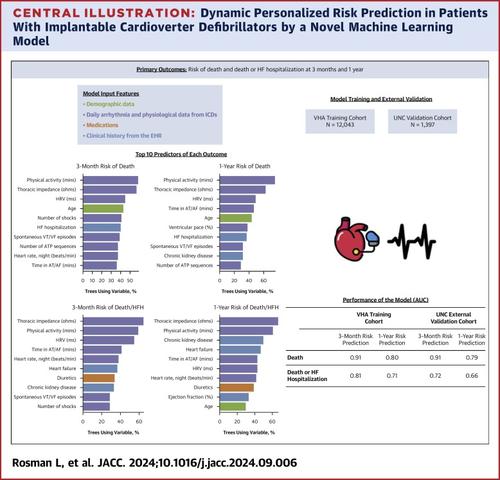当前位置:
X-MOL 学术
›
J. Am. Coll. Cardiol.
›
论文详情
Our official English website, www.x-mol.net, welcomes your
feedback! (Note: you will need to create a separate account there.)
Machine Learning-Based Prediction of Death and Hospitalization in Patients With Implantable Cardioverter Defibrillators
Journal of the American College of Cardiology ( IF 21.7 ) Pub Date : 2024-11-20 , DOI: 10.1016/j.jacc.2024.09.006 Lindsey Rosman PhD, Rachel Lampert MD, Kaicheng Wang MD MPH, Anil K. Gehi MD, James Dziura PhD, Elena Salmoirago-Blotcher MD PhD, Cynthia Brandt MD MPH, Samuel F. Sears PhD ABPP, Matthew Burg PhD
Journal of the American College of Cardiology ( IF 21.7 ) Pub Date : 2024-11-20 , DOI: 10.1016/j.jacc.2024.09.006 Lindsey Rosman PhD, Rachel Lampert MD, Kaicheng Wang MD MPH, Anil K. Gehi MD, James Dziura PhD, Elena Salmoirago-Blotcher MD PhD, Cynthia Brandt MD MPH, Samuel F. Sears PhD ABPP, Matthew Burg PhD

|
Predicting the clinical trajectory of individual patients with implantable cardioverter-defibrillators (ICDs) is essential to inform clinical care. Machine learning approaches can potentially overcome the limitations of conventional statistical methods and provide more accurate, personalized risk estimates.
中文翻译:

基于机器学习的植入式心律转复除颤器患者死亡和住院预测
预测植入式心律转复除颤器 (ICD) 个体患者的临床轨迹对于为临床护理提供信息至关重要。机器学习方法有可能克服传统统计方法的局限性,并提供更准确、个性化的风险估计。
更新日期:2024-11-20
中文翻译:

基于机器学习的植入式心律转复除颤器患者死亡和住院预测
预测植入式心律转复除颤器 (ICD) 个体患者的临床轨迹对于为临床护理提供信息至关重要。机器学习方法有可能克服传统统计方法的局限性,并提供更准确、个性化的风险估计。































 京公网安备 11010802027423号
京公网安备 11010802027423号